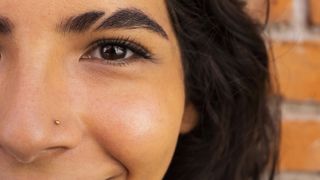
Why do we have eyebrows and eyelashes?
Do they serve a function beyond style?

From slitted eyebrows to fake eyelashes, alterations to hair around the eyes have become important ways to express personal style. But brows and lashes are more than just decorations.
So why do humans have eyebrows and eyelashes?
The main purpose of both is to protect the eyes, said Dr. Stephanie Marioneaux, the clinical spokesperson for the American Academy of Ophthalmology. "Their goal is to be another layer of protection for the actual eyeball against whatever it is — whether it's liquid, whether it's solid, whether it's dust, whether it's bugs or insects."
Related: Why do people get 'bags' under their eyes?
The eyebrows protect the eyes from substances, like sweat, dandruff and rain, that tumble down the face, Marioneaux told Live Science. They may catch or absorb the material, or their angle may direct it to the side of the face, away from the eyes.
The eyebrows serve a few other functions. For one, eyebrows are crucial for facial expression and communicating subtle emotions, and the eyebrow ridge may have evolved to allow for more expressive eyebrow movements, according to a 2018 virtual modeling study published in the journal Nature Ecology & Evolution.
Eyelashes offer similar protection to the eyes, but they do so in a different way. "They're almost like the whiskers of the face," Marioneaux said. They're long and sensitive. When something touches them, it triggers the blink response as a defense mechanism. Without the eyelashes, it would take longer for the blink response to activate, because the main trigger would be seeing something coming at the eye, Marioneaux said. "But this gives you a little bit of warning that something is in the vicinity that may actually injure the eye," she said.
Sign up for the Live Science daily newsletter now
Get the world’s most fascinating discoveries delivered straight to your inbox.
Eyelashes can also catch liquid, dust and other eye irritants. And they may help to keep the eyes moist by limiting evaporation, according to a 2019 study in the Journal of the Royal Society Interface.
Some conditions can cause people to lose their eyebrows or eyelashes. Alopecia, also known as patchy hair loss, can affect both. Sometimes, eyelashes fall out for unknown reasons, or a person may pluck out their lashes either because they're irritating or because of anxiety. In other cases, people with a condition known as trichotillomania have a compulsion to pull out their hair. An underactive thyroid can cause the eyebrows to thin, and lupus may make them fall out. If you notice that your eyebrows or eyelashes are thinning, falling out or otherwise changing, see a doctor, Marioneaux recommended.
If you do decide to alter your eyebrows for cosmetic reasons beyond mascara, be careful, particularly if you're dyeing them. Make sure the dye is safe for use around the eyes, and avoid getting it in the eye itself, Marioneaux said. You shouldn't dye your eyelashes, but some people may use an eye-drop lash enhancer to make their eyelashes longer and thicker. The eye drop is actually a glaucoma drug that can be used to grow the lashes. If you do use this drug, be aware that it can cause dark circles under the eyes.
Originally published on Live Science.

Tyler Santora is a freelance science and health journalist based out of Colorado. They write for publications such as Scientific American, Nature Medicine, Medscape, Undark, Popular Science, Audubon magazine, and many more. Previously, Tyler was the health and science Editor for Fatherly. They graduated from Oberlin College with a bachelor's degree in biology and New York University with a master's in science journalism.
Most Popular


